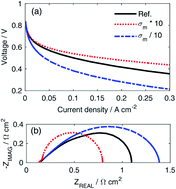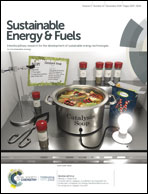Analysis of the effect of catalyst layer thickness on the performance and durability of platinum group metal-free catalysts for polymer electrolyte membrane fuel cells†
Abstract
Development of platinum group metal-free catalysts for polymer electrolyte membrane fuel cells is a critical target to obtain a high market share of fuel cell electric vehicles in the long term. Recent studies have proved the feasibility of new materials with high catalytic activity towards the oxygen reduction reaction, which are based on Earth-abundant and low-cost elements. The stability of these materials is now the major concern at the current state of the art: in the initial hundreds of hours of operation, in fact, a significant loss of catalyst activity is observed. In the present work, the analysis of performance and degradation of cathode catalyst layers based on metal–nitrogen–carbon materials is carried out for 150 hours. The effects of catalyst loading and ionomer content are being analyzed. Electrochemical impedance spectroscopy is adopted to gain insight into the ageing and the results are interpreted by means of a 1D physics-based model. A regime is reported to occur, in which ion, electron and oxygen transport limitations interplay and the effect of each phenomenon is distinguished on the impedance spectra and polarization curves. Degradation is shown to mainly affect the catalyst activity or the density of active sites, but also a loss of electrical and ionic conductivity is observed.

- This article is part of the themed collection: 2019 Sustainable Energy and Fuels HOT Articles


 Please wait while we load your content...
Please wait while we load your content...